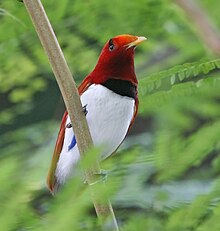Bird clade in the order of Passeriformes
Corvides is a clade of birds in the order of Passeriformes .[ 1] Corvoidea ,[ 2] [ 3] [ 2] [ 4] [ 5] [ 6] [ 7] [ 8] [ 9] [ 10] radiation , which colonized all continents except Antarctica .[ 11]
Systematics
Corvides contains the following families:[ 12] [ 2]
References
^ McCullough, J.M. et al . (2022) Wallacean and Melanesian Islands Promote Higher Rates of Diversification within the Global Passerine radiation Corvides . Systematic Biology , syac044, https://doi.org/10.1093/sysbio/syac044
^ a b c Jønsson K.A., Fabre P.-H., Kennedy J.D., Holt B.G., Borregaard M.K., Rahbek C., Fjeldså J. (2016) A supermatrix phylogeny of corvoid passerine birds (Aves: Corvides) . Mol.Phylogenet. Evol. 94:87–94.
^ Jønsson K.A., Fabre P.-H., Ricklefs R.E., Fjeldså J. 2011. Major global radiation of corvoid birds originated in the proto-Papuan archipelago . Proc. Natl. Acad. Sci. U. S. A. 108:2328–2333.
^ Jønsson K.A., Borregaard M.K., Carstensen D.W., Hansen L.A., Kennedy J.D., Machac A., Marki P.Z., Fjeldså J., Rahbek C. (2017) Biogeography and Biotic Assembly of Indo-Pacific Corvoid Passerine Birds . Annu. Rev. Ecol. Evol. Syst. 48:231–253.
^ Marki P.Z., Fabre P.-H., Jønsson K.A., Rahbek C., Fjeldså J., Kennedy J.D. (2015) Breeding system evolution influenced the geographic expansion and diversification of the core Corvoidea (Aves: Passeriformes) . Evolution. 69:1874–1924.
^ Kennedy J.D., Borregaard M.K., Jønsson K.A., Holt B., Fjeldså J., Rahbek C. (2017) Does the colonization of new biogeographic regions influence the diversification and accumulation of clade richness among the Corvides (Aves: Passeriformes)? Evolution. 71:38–50.
^ Kennedy J.D., Borregaard M.K., Jønsson K.A., Marki P.Z., Fjeldså J., Rahbek C. (2016) The influence of wing morphology upon the dispersal, geographical distributions and diversification of the Corvides (Aves; Passeriformes) . Proceedings of the Royal Society B: Biological Sciences. 283:20161922.
^ Kennedy J.D., Borregaard M.K., Marki P.Z., Machac A., Fjeldså J., Rahbek C. (2018) Expansion in geographical and morphological space drives continued lineage diversification in a global passerine radiation . Proceedings of the Royal Society B.
^ Kennedy J.D., Marki P.Z., Fjeldså J., Rahbek C. (2020) The association between morphological and ecological characters across a global passerine radiation . J. Anim. Ecol. 89:1094–1108.
^ Kennedy J.D., Marki P.Z., Fjeldså J., Rahbek C. (2021) Peripheral eco‐morphology predicts restricted lineage diversification and endemism among corvoid passerine birds . Glob. Ecol. Biogeogr. 30:79–98.
^ Aggerbeck, M., Fjeldså, J., Christidis, L., Fabre, P.-H., Jønsson, K.A., (2014) Resolving deep lineage divergences in core corvoid passerine birds supports a proto407 Papuan island origin . Molecular Phylogenetics and Evolution 70, 272–285.
^ Gill, F., M. Wright, & D. Donsker. (2010) IOC World Bird Names, version 2.7.
Genera of
corvides and their extinct allies









